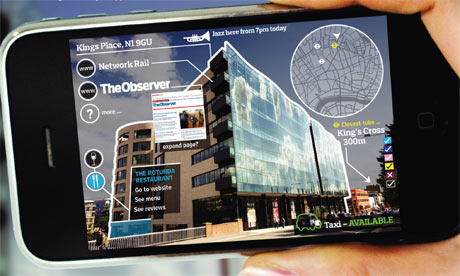 Don’t act too surprised if, some time in the next year, you meet someone who explains that their brochure is actually an augmented reality brochure.
Don’t act too surprised if, some time in the next year, you meet someone who explains that their brochure is actually an augmented reality brochure.
In the past year and for the next few years, we will hear the phrase augmented reality brochure much more often. And, by adding a special marker to the brochure, once put in front of a webcam linked to the internet, will show not only your contact details but also a video or sound clip. Or pretty much anything you want.
It’s not just an augmented reality brochure, but business cards, magazine advertising & direct mail too. By adding little barcode symbols, which, when viewed through a webcam, come to life, providing more information about the company, the service & the campaign. A single page advert is no longer a single page – it becomes a video, a website, therefore packing so much more into that single page advertising fee.
Even June’s edition of BBC Focus Magazine has been set up to show you just what can be done. Whilst this is not an augmented reality brochure, it is a magazine. Hold the magazine’s front cover up to a webcam and watch what happens on screen. Perhaps if you are an arachnophobe, don’t try it, but the sight of spiders crawling around the page is exciting and bewildering at the same time.
Augmented reality is relevant for many industries – even the fashion world has embraced it. Benetton is using AR for their It’s My Time campaign that kicked off last month, in which it is trying to find models from among the general population.
Adidas, too, has launched trainers with AR symbols in the tongues: hold them to a webcam and you are taken to interactive games on the Adidas site.
Augmented reality – AR, as it has quickly become known – has only recently become a phrase that trips easily off technologists’ lips; yet we’ve been seeing versions of it for quite some time. The idea is straightforward enough: take a real-life scene, or (better) a video of a scene, and add some sort of explanatory data to it so that you can better understand what’s going on, or who the people in the scene are, or how to get to where you want to go.
Sports coverage on TV has been doing it for years: the superimposed winning line in a rowing race orthe swimmer’s name superimposed onto the lane they are in. More recently cricket, tennis, rugby, football and golf have all started to overlay analytic information on top of standard-speed replays – would that ball have hit the stumps, the progress of a rally, the movement of the backs or wingers, the relative flights of shots – to tell you more about what’s going on.
AR took its first lumbering steps into the public arena eight years ago: all that you needed to do was strap on 10kg of computing power – laptop, camera, vision processor – and you could get an idea of what was feasible. The American Popular Science magazine wrote about the idea in 2002 – but the idea of being permanently connected to the internet hadn’t quite jelled at that point.
“AR has been around for ages,” says Andy Cameron, executive director of Fabrica, an interactive design studio which works with Benetton, “maybe going back as far as the 1970s and art installations that overlaid real spaces with something virtual.” He mentions in particular the work of pioneering computer artist Myron Krueger.
What’s changed in the past year is that AR has come within reach of all sorts of developers – and the technology powerful enough to make use of it is owned by millions of people, often in the palms of their hands.
The arrival of powerful smartphones and computers with built-in video capabilities means that you don’t have to wait for the AR effects as you do with TV. They can simply be overlaid onto real life. Step forward Apple’s iPhone, and phones using Google’s Android operating system, both of which are capable of overlaying information on top of a picture or video.
Within the small world of AR, one of the best-known apps is that built by Layar, which – given a location, and using the iPhone 3GS’s inbuilt compass to work out the direction you’re pointing the phone – can give you a “radar map” of details such as Wikipedia information, Flickr photos, Google searches and YouTube videos superimposed onto a picture you’ve taken of the scene.
More usefully, Yelp offers an augmented reality brochure application that will show you ratings and reviews for a restaurant before you walk in – the sort of thing that could make restaurants quiver with delight, or shudder in horror.
Going further, the application can get personal, very personal. A prototype application demonstrated at the Mobile World Congress in Barcelona in February showed the scary future. Point the phone at a person and, using facial recognition software, it can pull their information off the web and attach details – their Twitter username, Facebook page, preferences and other facts – and stick them, rather weirdly, into the air around their head (viewed through your phone, of course).
Social networking may never be the same again.
